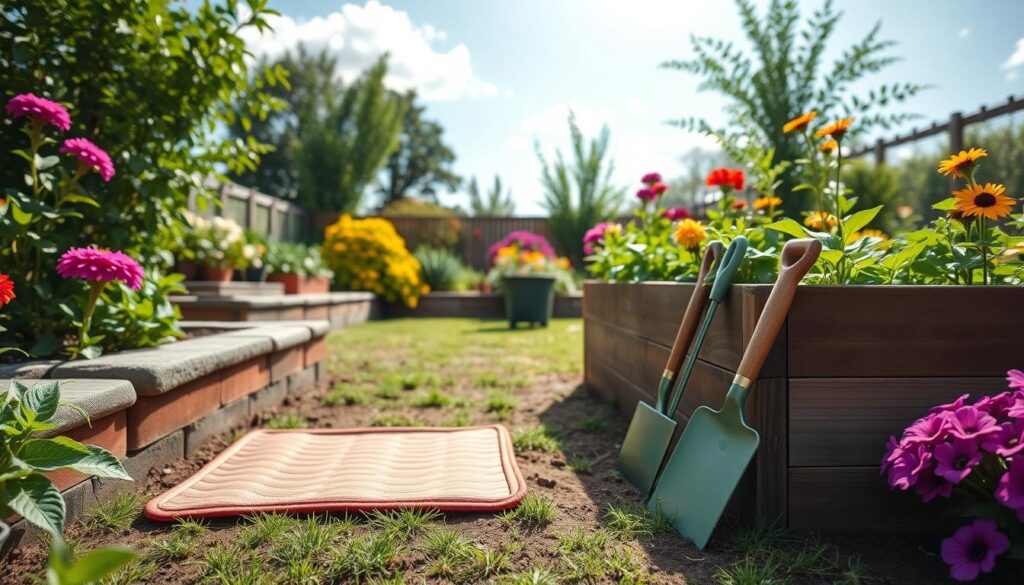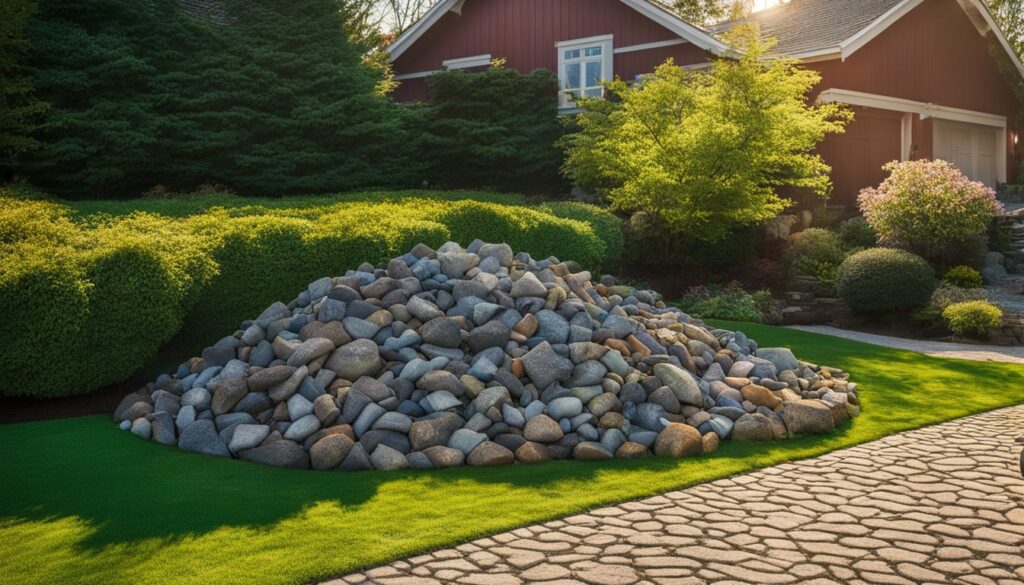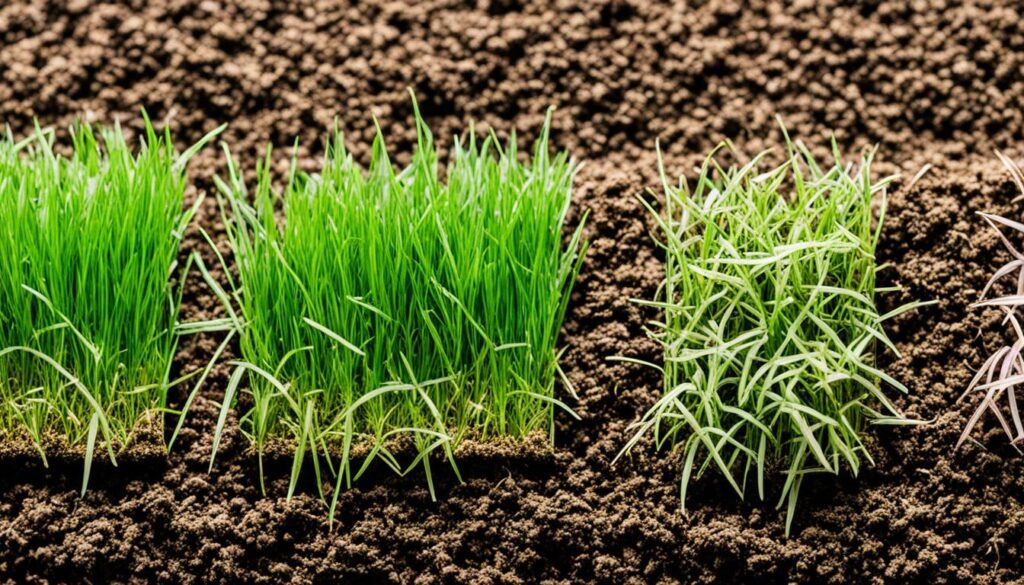Did you know that over 100 types of arthritis can cause knee pain? This isn’t just a problem for the elderly. It also affects people who love gardening. Gardener’s knee pain, like prepatellar bursitis, is common among gardeners. It leads to inflammation and strain in the joints.
This article will look at how gardening can lead to knee pain. Activities like kneeling and bad posture can strain the knees. Even dedicated gardeners can experience pain. But, with the right steps, we can keep our knees healthy. Using knee pads and maintaining good posture can help lower the risk of knee problems.
To learn more about how to prevent knee injuries while gardening, check out this article on preventing knee injuries in gardening.
Key Takeaways
- Proper footwear reduces the impact on knees while gardening on hard surfaces.
- Knee pads or garden stools help prevent knee stress during prolonged kneeling.
- Maintaining proper posture, like keeping a straight back, significantly lowers knee pain risk.
- Stretching before and after gardening improves flexibility and reduces injury risk.
- Awareness of conditions like osteoarthritis is crucial for avid gardeners.
- Non-surgical treatments and lifestyle changes can effectively manage knee conditions.
Introduction to Gardening and Knee Pain
Gardening brings joy but can also bring knee pain. Every year, over 4 million people face knee problems. These issues can come from genetics or past injuries. Even simple tasks like planting and weeding can cause knee injuries if you’re not careful.
It’s important to know how gardening affects your knees. This knowledge helps me enjoy gardening more while avoiding pain. Seeing a doctor is key if you have knee issues. They can suggest exercises to strengthen your knees.
To avoid knee pain while gardening, there are steps you can take. Wearing the right shoes helps keep your knees aligned and supported. Before gardening, doing a warm-up can ease the pressure on your knees. Stretching your thighs is an easy way to stay flexible and lower your risk.
Using adaptive gardening methods helps if you have knee pain. For example, choosing low-maintenance trees and raised beds with benches makes gardening easier. Using dirt paths instead of hard pavement also reduces knee pressure, letting me enjoy gardening more.
Getting tools like knee pads or long-handled tools makes gardening more comfortable. By using these tips and keeping an eye on your knee health, you can keep enjoying gardening without the pain.
What is Gardener’s Knee Pain?
Gardener’s knee pain is also known as prepatellar bursitis. It happens when the bursa in front of the kneecap gets inflamed. This usually comes from kneeling on hard surfaces for a long time. It leads to swelling and fluid buildup in the bursa.
Knowing about this condition helps in managing and preventing knee strain while gardening.
Understanding Prepatellar Bursitis
Prepatellar bursitis mainly affects people who do activities that involve a lot of knee bending or kneeling. Gardeners often experience this because they spend a lot of time on their knees. Early signs include irritation and pain when kneeling or bending the knee.
These symptoms can lead to swelling, redness, and more pain if not treated. It’s crucial to catch these signs early to avoid affecting daily activities.
Symptoms of Knee Pain from Gardening
Gardener’s knee pain can make gardening hard to enjoy. The main symptoms are:
- Swelling around the kneecap
- Pain during movement
- Sensitivity in the knee area
- Increased discomfort after prolonged kneeling or gardening activities
Recognizing these symptoms early helps gardeners take steps to ease the pain and prevent further issues.
| Symptom | Details |
|---|---|
| Swelling | Noticeable swelling around the kneecap, often seen after prolonged kneeling. |
| Pain | Experiencing pain when moving the knee, particularly during bending. |
| Sensitivity | Heightened sensitivity in the knee area, making it uncomfortable to apply pressure. |
| Difficulty moving | Challenges in bending or walking, especially after gardening tasks. |
Can Gardening Cause Knee Pain?
Gardening can lead to knee pain, especially if you kneel a lot or lift heavy things. Many factors can cause this discomfort.
Common Causes of Knee Pain in Gardeners
Repeating certain movements and using the wrong techniques can lead to gardener’s knee, or prepatellar bursitis. This happens when the bursa at the front of the kneecap gets inflamed. Common causes include:
- Prolonged kneeling without adequate support.
- Poor lifting techniques leading to added stress on the knees.
- Inadequately supportive footwear that fails to provide necessary cushioning.
Risk Factors for Developing Knee Pain
Some factors increase the chance of getting knee pain from gardening. This is true for people of all ages, especially those with conditions like arthritis. Not being physically fit can also make you more likely to get hurt. Other risks are:
- Engaging in frequent high-impact gardening activities without appropriate precautions.
- Not using knee pads or supportive gear during gardening tasks.
- Neglecting to warm up and stretch before starting gardening activities.
| Common Causes | Risk Factors |
|---|---|
| Prolonged kneeling | Age |
| Poor lifting techniques | Pre-existing conditions (e.g., arthritis) |
| Inadequate footwear | Lack of physical conditioning |
| Improper body mechanics | High-impact gardening without precautions |
Knee Strain from Gardening: How It Happens
Gardening is a great way to relax, but it can also strain your knees. Knowing why this happens can help you avoid getting hurt.
Excessive Kneeling and Its Effects
Kneeling is key in gardening, but doing it too much can harm your knees. It can cause prepatellar bursitis, making the kneecap area swell and hurt. This happens when the bursa, which protects the kneecap, gets inflamed.
Working on hard ground makes it even worse. Over 300,000 people get hurt while gardening each year. This shows we need to be careful and take steps to prevent injuries.
Improper Posture During Gardening Activities
Bad posture while gardening can also strain your knees. Leaning too far or bending your knees too much puts extra stress on them. It’s important to keep your back straight and avoid putting pressure on your knees.
Using knee-friendly gardening tips can prevent injuries and make gardening more enjoyable.
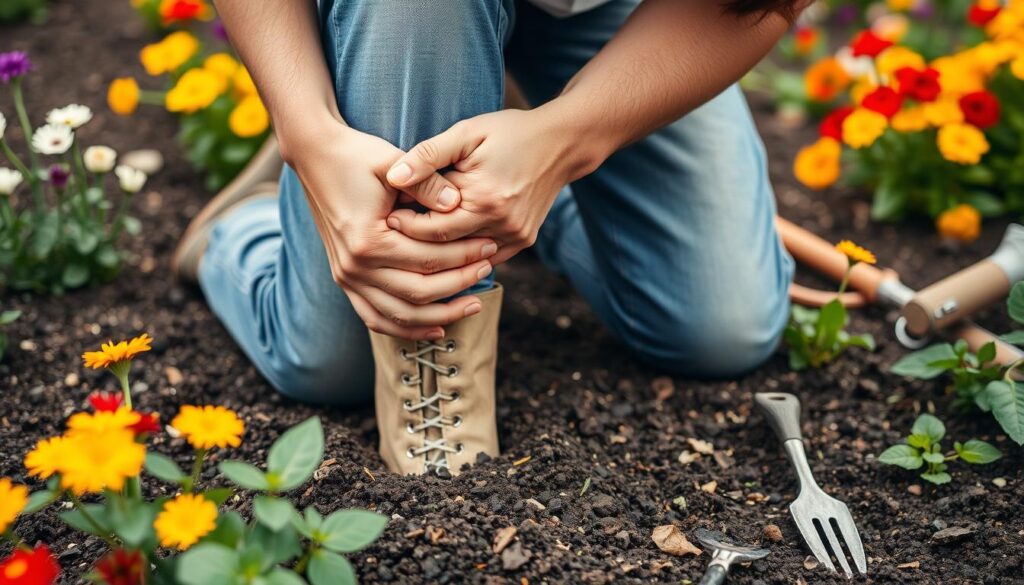
| Common Causes of Knee Strain in Gardening | Preventive Measures |
|---|---|
| Excessive Kneeling | Use garden kneepads or kneeling benches |
| Poor Posture | Practice good body mechanics while gardening |
| Hard Surfaces | Avoid prolonged kneeling on concrete or gravel |
| Improper Tool Use | Choose ergonomic tools and maintain proper posture |
| Lack of Warm-Up | Incorporate stretching before gardening sessions |
Preventing Knee Pain While Gardening
Gardening is great for your health but can hurt your knees if you don’t take care. It’s key to know how to avoid knee pain to keep gardening fun and healthy. Here are some tips to help you take care of your knees while gardening.
Importance of Proper Footwear
Wearing the right shoes is key to avoiding knee pain in the garden. Gardening shoes are made to absorb shock and keep your feet stable. This helps prevent injuries and makes gardening more enjoyable.
Using Garden Knee Pads and Other Aids
Knee pads for gardening can really help reduce knee strain. They add cushioning and support, protecting your knees from long periods of pressure. Using raised beds or stools can also ease knee pressure, making gardening more comfortable.
Knee-Friendly Gardening Tips and Techniques
Using knee-friendly gardening methods is important to avoid pain. Take breaks often, stretch before and after, and switch positions to keep your knees safe. Long-handled tools also help you avoid bending, which can strain your knees. These tips help you garden without hurting your joints.
Exercises and Stretches for Knee Care
Before I start gardening, I make sure to stretch my knees. These stretches focus on the hamstrings, quadriceps, and calves. Doing gardening knee stretches makes my knees more flexible. It also gets them ready for gardening, which lowers the chance of getting hurt.
Effective Knee Stretches Before Gardening
Stretching helps prevent knee pain by strengthening muscles and avoiding overuse. It’s important to stretch the ankles and hips too. This keeps the knees healthy and reduces strain.
- Start with a hamstring stretch: Stand tall and reach for my toes while keeping my legs straight for about 15-30 seconds.
- Move on to a quadriceps stretch: While standing, pull one foot toward my buttock, holding for 15-30 seconds.
- Finish with a calf stretch: Position myself against a wall, placing one foot back while pressing the heel to the ground for 15-30 seconds.
Doing these gardening knee stretches often helps ease pain and stops injuries before they happen. I check out simple exercises for knee pain for more tips on knee exercises.
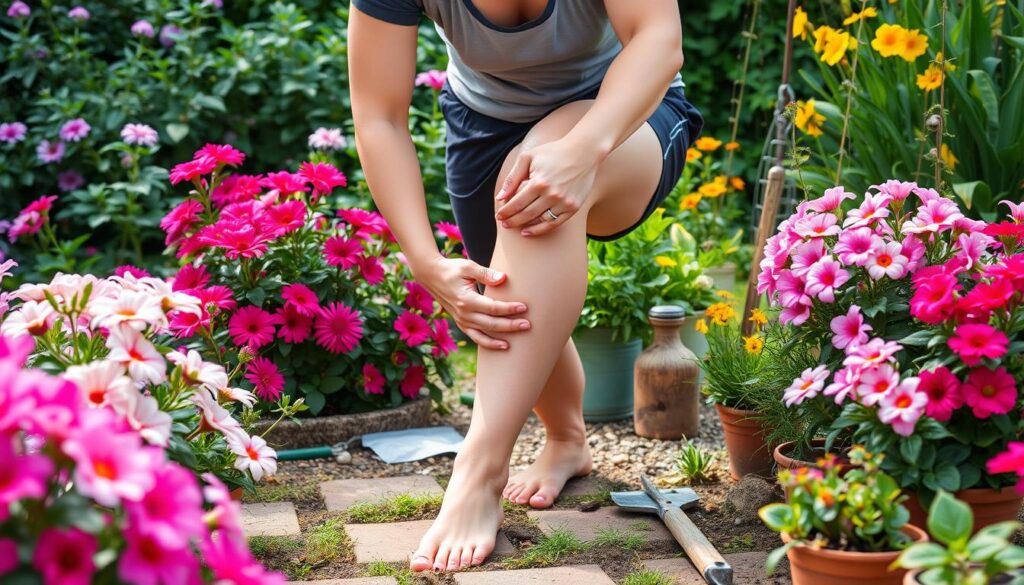
| Stretch Type | Target Area | Duration |
|---|---|---|
| Hamstring Stretch | Hamstrings | 15-30 seconds |
| Quadriceps Stretch | Quadriceps | 15-30 seconds |
| Calf Stretch | Calves | 15-30 seconds |
By adding these stretches to my routine, I’ve seen better mobility and less knee pain. This lets me keep enjoying my gardening.
Treatments for Gardening-Related Knee Pain
Gardening knee injuries can be tough and uncomfortable. Knowing the right treatments is key to easing the pain. Often, simple steps at home can help manage the symptoms.
Using Ice and Medication for Relief
For knee pain from gardening, resting and using ice can help a lot. Applying ice packs for 10-20 minutes can ease the soreness. Over-the-counter pain relievers like ibuprofen can also help reduce discomfort. These steps might be enough for minor pain.
When to Seek Professional Help
If pain doesn’t go away with rest and home care, seeing a healthcare professional is important. This could mean there’s a deeper issue that needs special care. A doctor might suggest physical therapy, including using a knee brace or doing exercises to strengthen the knee. Knowing when to get professional help ensures serious issues get the right attention.
Knee-Friendly Gardening Tools and Practices
Creating a comfortable gardening space is key to avoiding pain and keeping gardening fun. I’ve found that using knee-friendly tools and practices helps a lot. These changes make gardening easier and more fun.
Using Raised Garden Beds
Raised garden beds are a big help in easing knee strain. They let me care for my plants without kneeling too much. You can choose the height of these beds to fit what you like, making it easier to tend to your plants. Raised beds also help with soil drainage and can make your growing season longer.
Choosing Long-handled Tools
Long-handled gardening tools are great for easing knee stress. They let me work without bending over, keeping my back straight. Tools like the Peta Easi-Grip Long Reach Garden Tools are designed to reduce strain. They show how I keep my knees safe while gardening.
Getting advice from experts helps me learn how to protect my knees. It also helps me keep up a gardening routine that’s good for my health.
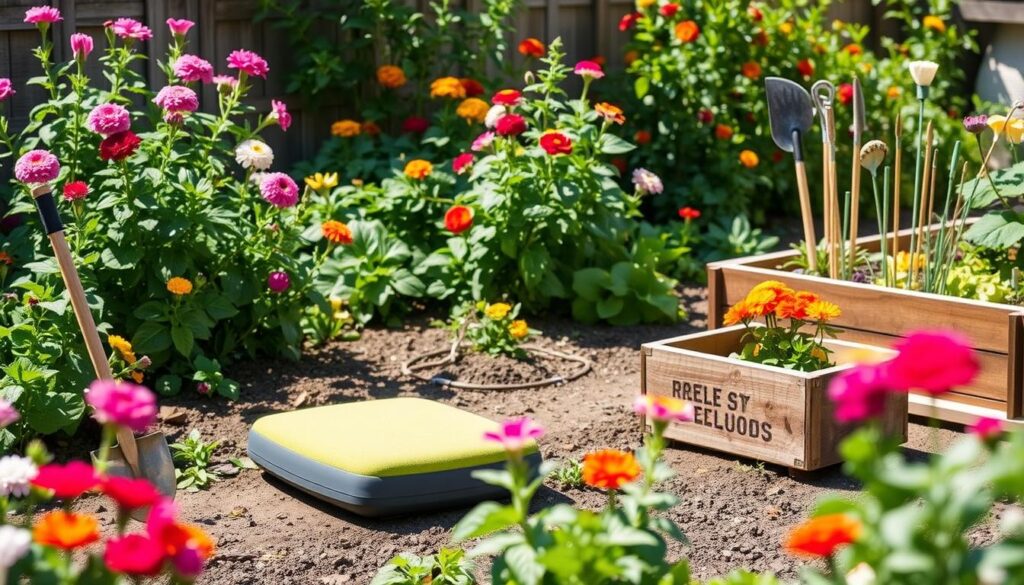
Importance of Taking Breaks and Changing Positions
Taking regular breaks while gardening is key to prevent knee pain gardening. These breaks let my body recover and ease the pain from repetitive tasks. They also let me check my gardening tasks and change my methods for better results.
Switching positions helps reduce strain and boosts circulation. This is crucial if I’m kneeling or bending for a long time. Changing how I stand or sit spreads the weight on different muscles, lowering the chance of joint pain.
To stop preventing knee pain gardening, I follow some simple rules. I use lightweight tools and long handles to make gardening easier. I also use raised beds and stools to avoid bending too much, keeping me comfortable and supported.
Adding stretching and gentle moves to my gardening routine helps keep me flexible. Studies show that a 10-minute walk before gardening keeps my muscles ready. Staying aware of my body’s signals helps me manage my activities wisely.
Planning my garden with low-care plants means I don’t need to work on it too much. This approach lowers the risk of injuries while still letting me enjoy gardening. For more tips on protecting my joints while gardening, the info at this resource is really helpful.
| Strategy | Benefit |
|---|---|
| Regular Breaks | Reduces discomfort and allows for recovery |
| Changing Positions | Prevents stiffness and promotes circulation |
| Ergonomic Tools | Minimizes strain on joints |
| Elevated Beds | Reduces bending and kneeling |
| Low-Maintenance Gardens | Lowers risk of overuse injuries |
Conclusion
For gardeners like me, knowing how gardening affects our knees is key. It helps us spot injuries early and take steps to prevent them. This way, I can keep enjoying my garden without worrying about knee pain.
To make gardening safer, I always use the right tools and wear knee pads. I also take breaks to rest my knees. These steps help prevent injuries like knee bursitis and sprains. They make gardening more comfortable and fun.
Being careful with how I move in the garden also helps. I avoid putting too much strain on my knees when I squat or kneel. This keeps my knees happy and healthy.
By taking care of my knees, I can fully enjoy my gardening hobby. With the right knowledge and actions, I can garden without worrying about knee pain. This makes gardening even more rewarding.
FAQ
Can gardening cause knee pain?
Yes, gardening can lead to knee pain. This is due to activities like kneeling for a long time, lifting incorrectly, and not using the right body mechanics. These actions can cause prepatellar bursitis.
What are common symptoms of knee pain from gardening?
Symptoms include swelling around the kneecap, pain when moving, tenderness in the knee, and sensitivity after kneeling or straining too much.
How can I prevent knee pain while gardening?
To avoid knee pain, follow these tips. Keep a good posture, wear supportive shoes, take breaks often, and use knee pads for gardening.
What is gardener’s knee pain?
Gardener’s knee pain, or prepatellar bursitis, is when the bursa in front of the kneecap gets inflamed. It’s often caused by kneeling a lot, leading to swelling and discomfort.
Are there specific stretches I can do for my knees before gardening?
Yes, doing hamstring, quadriceps, and calf stretches can help. These stretches make your knees more flexible and ready for gardening.
What tools can I use to reduce knee strain while gardening?
Use raised garden beds, garden stools, and long tools to lessen the need for bending and kneeling. This helps reduce knee strain.
When should I seek professional help for gardening-related knee pain?
If your knee pain doesn’t go away with rest and home remedies, see a healthcare professional. They can help with any underlying issues.
What are some effective knee-friendly gardening techniques?
To garden without straining your knees, change positions often, use long tools, and take regular breaks. This helps reduce strain and discomfort.
Can I use a knee brace while gardening?
Yes, a gardening knee brace can offer extra support and lower the risk of knee injuries. It’s good for those who feel pain while gardening.

